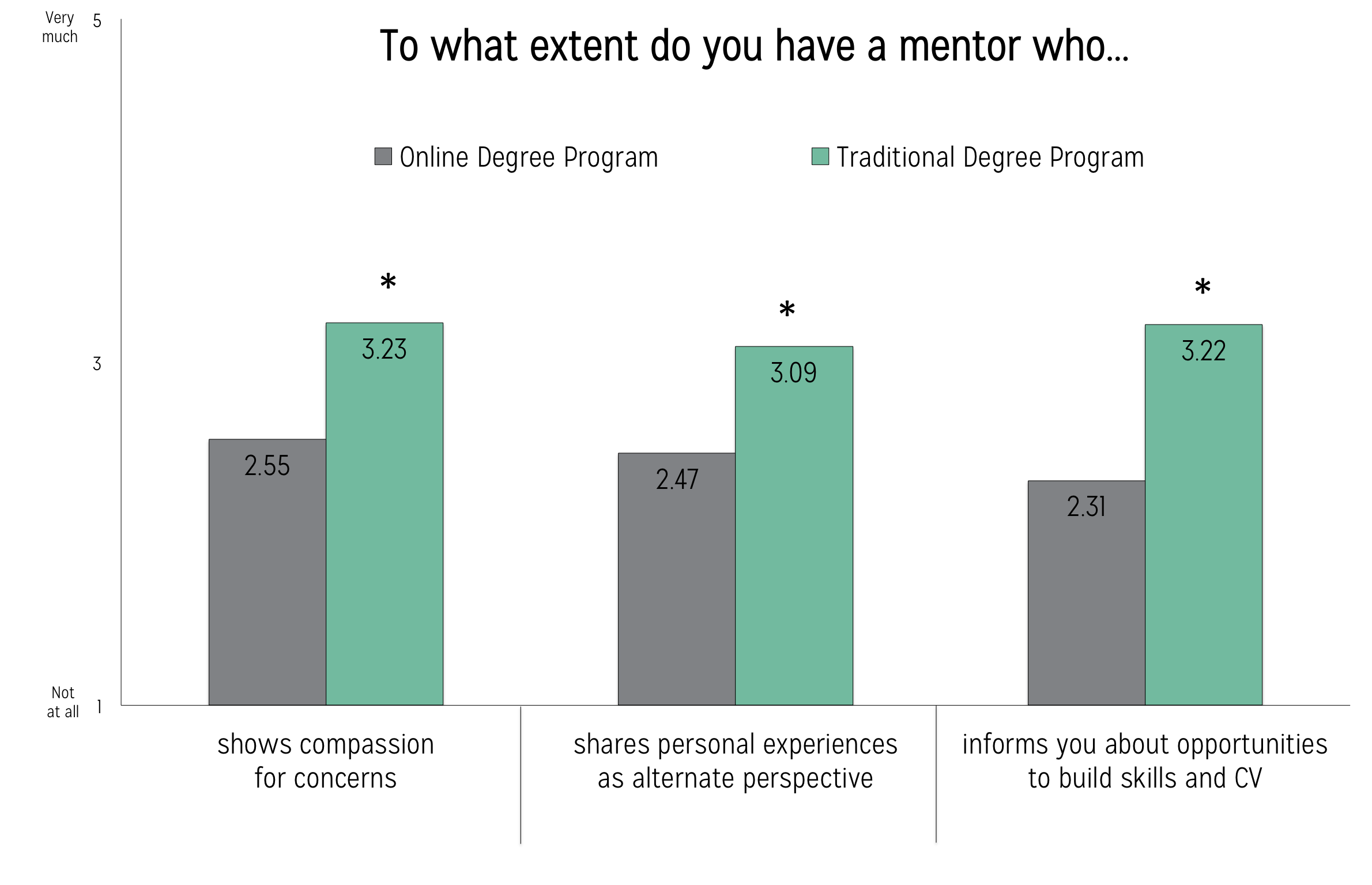Compared to Students in Traditional Master’s Degree Programs, Online Master’s Students Report Lower Mentorship Support

According to the new 2017 Taulbee Survey report, the production of CS master’s degrees in the U.S. rose more than 19 percent from 2016-2017, and the average number of new CS master’s students per department [1] last year was 93.8 students. As CS enrollments continue to rise, departments that are facing capacity issues may turn to online education as a means to manage the influx of new students. According to a report from Babson Survey Research Group, graduate-level distance education enrollments in all fields have grown 18 percent from 2012-2015, with percentage change as high as 33 percent at private non-profit institutions (Allen & Seaman, 2017).
Because students in online programs are not physically on campus, these students may not have access to as many academic mentors as their on-campus peers. To test this, CERP analyzed survey responses from joint bachelor’s/master’s and terminal master’s students earning their degree in a computing-related field [2]. Compared to students in traditional degree programs, students enrolled in online degree programs reported lower levels of mentorship support. Because mentorship is important for students’ success and persistence in academic degree programs (Campbell & Campbell, 1997; Pascarella, 1980; Kim & Sax, 2009), and especially underrepresented students in computing (Kendricks, Nedunuri & Arment, 2013; Kim & Sax, 2009), it is important that departments consider ways of increasing accessibility and/or visibility of mentorship resources to online students. Although time and financial limitations may hinder departments’ ability to do so, the following suggestions are ways in which departments can provide stronger mentorship resources for online students:
- Directing students to online mentorship resources such as the CRA-E CONQUER website [3] or MentorNet, which is a nonprofit organization that matches students in STEM with mentors through its website
- Hosting virtual office hours, and discussing professional development in addition to classwork
- Utilizing several teaching assistants who can serve as peer mentors
- Hosting visit days for online students during which students can meet peers and faculty in person
Departments that provide this mentorship support may help online master’s students persist in their computing degree programs.
Notes:
[1] The average number of new CS Master’s students per department was calculated using the number of CS, CE, and Informatics doctoral-granting departments in the U.S. that participate in the Taulbee Survey and report this information, n = 130 (Zweben & Bizot, 2018).
[2] The survey data used in this figure were collected during the fall 2017 by CERP via the Data Buddies Project. The total sample (n = 2,524) includes joint Bachelor’s/Master’s and terminal Master’s students earning their degree in a computing-related field (i.e., Computer Science, Computer Engineering, Computing Information Systems, and other computing). Using a scale from (1) Not at all to (5) Very much, survey respondents were asked to answer the following: To what extent do you have a mentor who (a) shows compassion for concerns and feelings you discussed with them (b) shares personal experiences as an alternative perspective to your problem (c) informs you about opportunities that would help you build skills or enhance your CV. Mean differences between online (n = 512) and traditional (n = 1,978) students were tested using independent samples t-tests. * p ≤ 0.01.
[3] The CRA-E CONQUER website is largely targeted at undergraduate students; however, CONQUER provides tips and advice about whether to pursue a Ph.D. in computing and how to chose a career path with a Ph.D. Finally, while this infographic exclusively focuses on master’s level students, CONQUER would also be a positive resource for undergraduate students within departments in both online and traditional degree programs.
References:
Allen, I. E. & Seaman, J. (2017). Digital learning compass: Distance education enrollment report 2017. Retrieved from Babson Survey Research Group website: https://www.onlinelearningsurvey.com/reports/digtiallearningcompassenrollment2017.pdf.
Campbell, T. A. & Campbell D. E. (1997). Faculty/student mentor program: Effects on academic performance and retention, Research in Higher Education, 38(6), pp 727-742.
Kendricks, K. D., Nedunuri, K. V., & Arment, A. R. (2013). Minority student perceptions of the impact of mentoring to enhance academic performance in STEM disciplines, Journal of STEM Education, 14(2), pp 38-46.
Kim, Y. K. & Sax, L. J. (2009). Student-faculty interaction in research universities: Differences by student gender, race, social class, and first-generation status, Research in Higher Education Journal, 50(5), pp 437-459.
Pascarella, E. T. (1980). Student-faculty informal contact and college outcomes, Review of Educational Research, 50(4), pp 545-595.
Zweben, S. & Bizot, B. (2018). 2017 CRA Taulbee Survey: Another year of record undergrad enrollment; Doctoral degree production steady while master’s production rises again. Retrieved from Computing Research Association website: https://cra.org/wp-content/uploads/2018/05/2017-Taulbee-Survey-Report.pdf.
 This analysis is brought to you by the CRA’s Center for Evaluating the Research Pipeline (CERP). CERP provides social science research and comparative evaluation for the computing community.
This analysis is brought to you by the CRA’s Center for Evaluating the Research Pipeline (CERP). CERP provides social science research and comparative evaluation for the computing community.
Do you have a research question you’d like CERP to answer? Submit ideas for future infographics here. Subscribe to the CERP newsletter here.
This material is based upon work supported by the National Science Foundation under grant numbers (CNS-1246649; and/ or DUE-1431112). Any opinions, findings, and conclusions or recommendations expressed in this material are those of the author and do not necessarily reflect the views of the National Science Foundation









